INTERNATIONAL FINANCIAL RELATIONS The substance of subject:

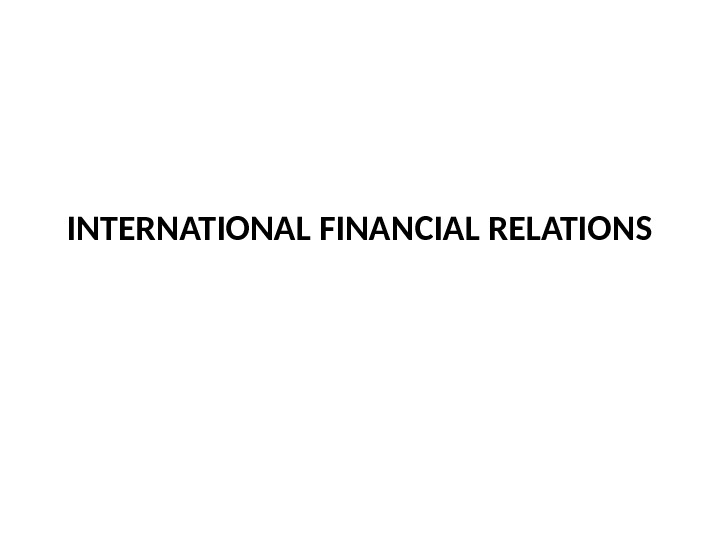
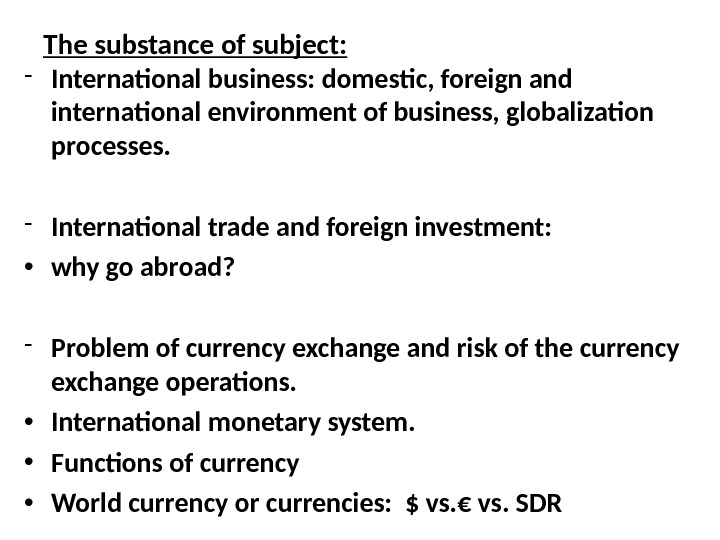
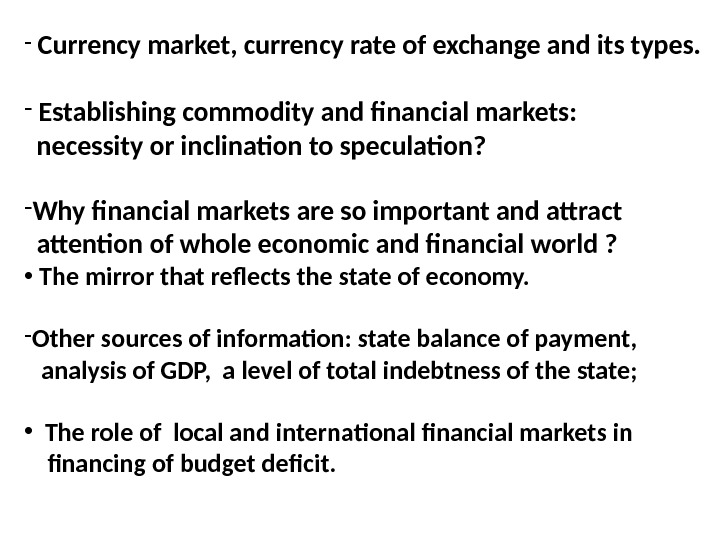
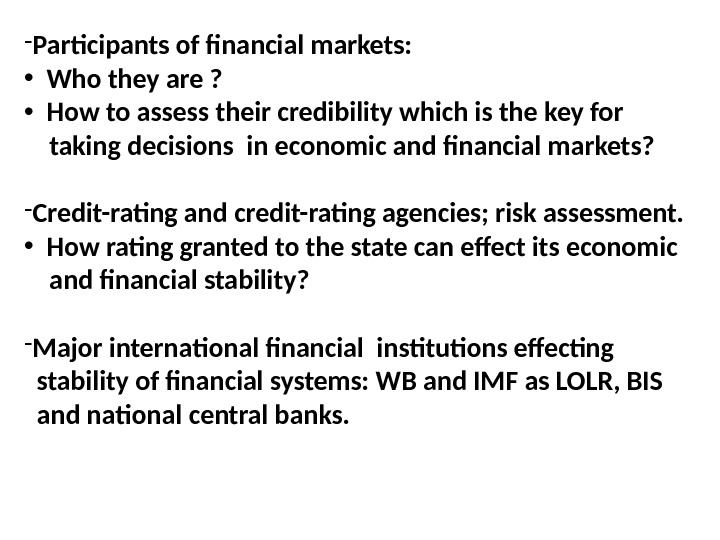

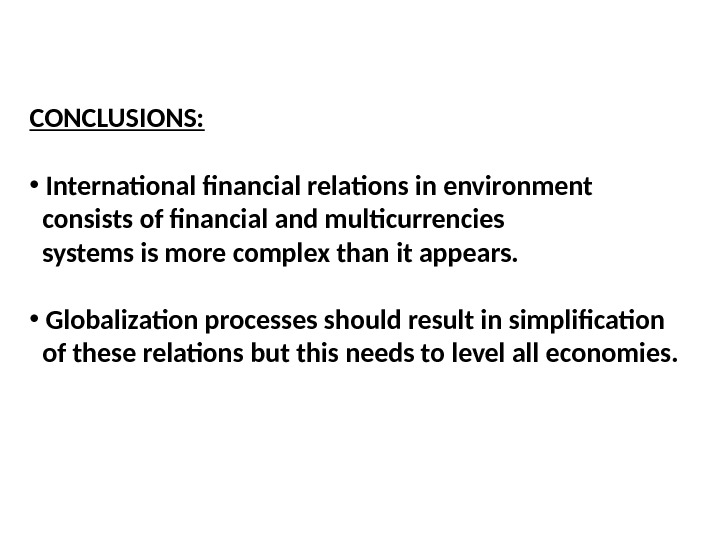
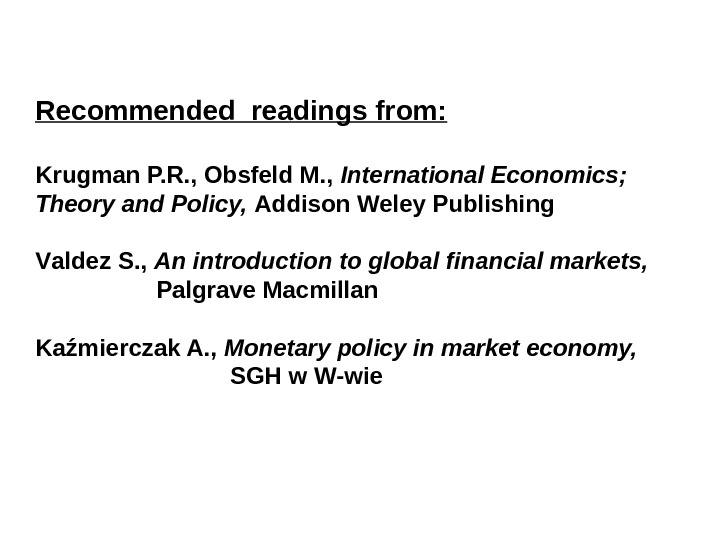
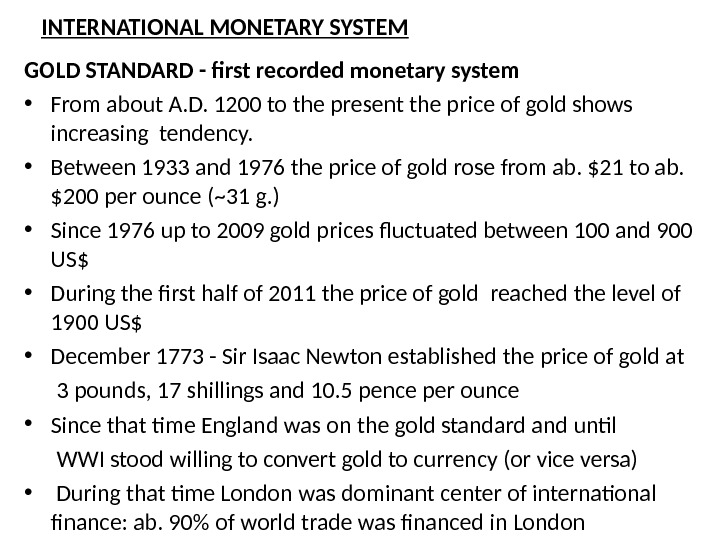

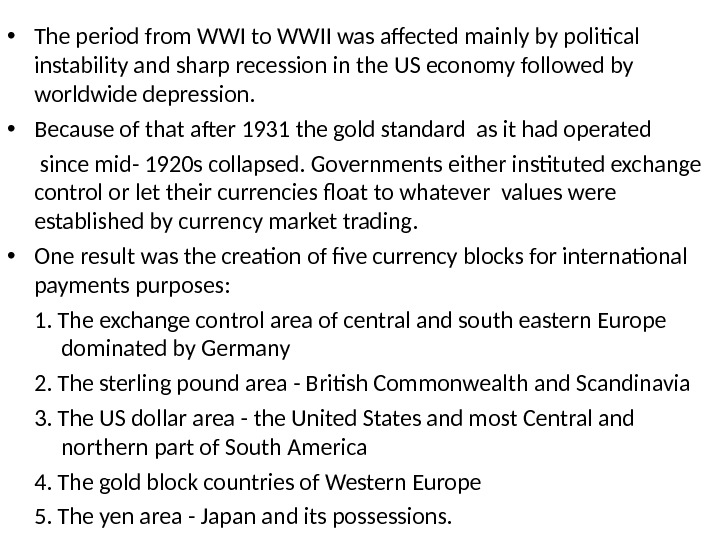
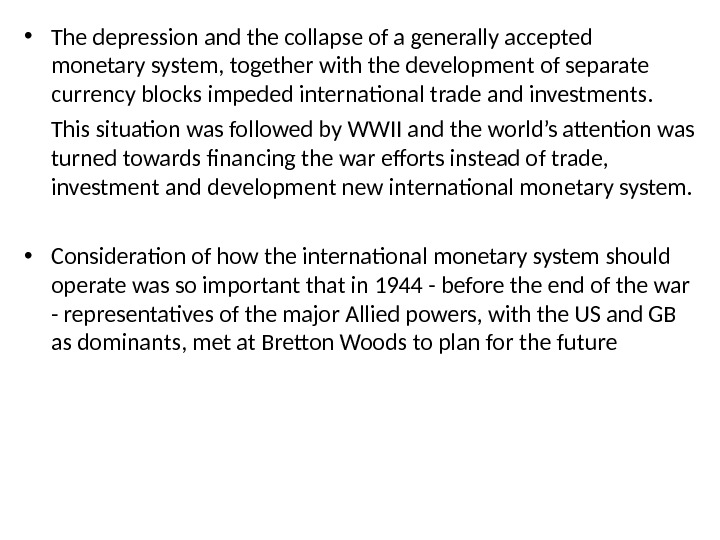
international_financial_relations.ppt
- Размер: 129.5 Кб
- Количество слайдов: 11
Описание презентации INTERNATIONAL FINANCIAL RELATIONS The substance of subject: по слайдам
 INTERNATIONAL FINANCIAL RELATIONS
INTERNATIONAL FINANCIAL RELATIONS
 The substance of subject: — International business: domestic, foreign and international environment of business, globalization processes. — International trade and foreign investment: • why go abroad? — Problem of currency exchange and risk of the currency exchange operations. • International monetary system. • Functions of currency • World currency or currencies: $ vs. € vs. SDR
The substance of subject: — International business: domestic, foreign and international environment of business, globalization processes. — International trade and foreign investment: • why go abroad? — Problem of currency exchange and risk of the currency exchange operations. • International monetary system. • Functions of currency • World currency or currencies: $ vs. € vs. SDR
 — Currency market, currency rate of exchange and its types. — Establishing commodity and financial markets: necessity or inclination to speculation? — Why financial markets are so important and attract attention of whole economic and financial world ? • The mirror that reflects the state of economy. — Other sources of information: state balance of payment, analysis of GDP, a level of total indebtness of the state; • The role of local and international financial markets in financing of budget deficit.
— Currency market, currency rate of exchange and its types. — Establishing commodity and financial markets: necessity or inclination to speculation? — Why financial markets are so important and attract attention of whole economic and financial world ? • The mirror that reflects the state of economy. — Other sources of information: state balance of payment, analysis of GDP, a level of total indebtness of the state; • The role of local and international financial markets in financing of budget deficit.
 — Participants of financial markets: • Who they are ? • How to asses s their credibility which is the key for taking decisions in economic and financial markets? — Credit-rating and credit-rating agencies; risk assessment. • How rating granted to the state can effect its economic and financial stability? — Major international financial institutions effecting stability of financial systems: WB and IMF as LOLR, BIS and national central banks.
— Participants of financial markets: • Who they are ? • How to asses s their credibility which is the key for taking decisions in economic and financial markets? — Credit-rating and credit-rating agencies; risk assessment. • How rating granted to the state can effect its economic and financial stability? — Major international financial institutions effecting stability of financial systems: WB and IMF as LOLR, BIS and national central banks.
 — Financial markets; operations and types of risk. • Risk management — International money and capital markets • Today — currency zones, eurozone and eurocurrency market: eurodollars, eurocurrency securities. • Tommorrow — how it will look like? Conglomerate of different, the most strongest, financial systems being built on sound economies, The only one dominant financial system and several „satellites”, One, global financial system with common currency, similar to Eurpean Economic and Monetary Union.
— Financial markets; operations and types of risk. • Risk management — International money and capital markets • Today — currency zones, eurozone and eurocurrency market: eurodollars, eurocurrency securities. • Tommorrow — how it will look like? Conglomerate of different, the most strongest, financial systems being built on sound economies, The only one dominant financial system and several „satellites”, One, global financial system with common currency, similar to Eurpean Economic and Monetary Union.
 CONCLUSIONS: • International financial relations in environment consists of financial and multicurrencies systems is more complex than it appears. • Globalization processes should result in simplification of these relations but this needs to level all economies.
CONCLUSIONS: • International financial relations in environment consists of financial and multicurrencies systems is more complex than it appears. • Globalization processes should result in simplification of these relations but this needs to level all economies.
 Recommended readings from: Krugman P. R. , Obsfeld M. , International Economics ; Theory and Policy, Addison Weley Publishing V aldez S. , An introduction to global financial markets, P algrave Macmillan Kaźmierczak A. , Monetary policy in market economy, SGH w W-wie
Recommended readings from: Krugman P. R. , Obsfeld M. , International Economics ; Theory and Policy, Addison Weley Publishing V aldez S. , An introduction to global financial markets, P algrave Macmillan Kaźmierczak A. , Monetary policy in market economy, SGH w W-wie
 INTERNATIONAL MONETARY SYSTEM GOLD STANDARD — first recorded monetary system • From about A. D. 1200 to the present the price of gold shows increasing tendency. • Between 1933 and 1976 the price of gold rose from ab. $21 to ab. $200 per ounce (~31 g. ) • Since 1976 up to 2009 gold prices fluctuated between 100 and 900 US$ • During the first half of 2011 the price of gold reached the level of 1900 US$ • December 1773 — Sir Isaac Newton established the price of gold at 3 pounds, 17 shillings and 10. 5 pence per ounce • Since that time England was on the gold standard and until WWI stood willing to convert gold to currency (or vice versa) • During that time London was dominant center of international finance: ab. 90% of world trade was financed in London
INTERNATIONAL MONETARY SYSTEM GOLD STANDARD — first recorded monetary system • From about A. D. 1200 to the present the price of gold shows increasing tendency. • Between 1933 and 1976 the price of gold rose from ab. $21 to ab. $200 per ounce (~31 g. ) • Since 1976 up to 2009 gold prices fluctuated between 100 and 900 US$ • During the first half of 2011 the price of gold reached the level of 1900 US$ • December 1773 — Sir Isaac Newton established the price of gold at 3 pounds, 17 shillings and 10. 5 pence per ounce • Since that time England was on the gold standard and until WWI stood willing to convert gold to currency (or vice versa) • During that time London was dominant center of international finance: ab. 90% of world trade was financed in London
 • Most trading and industrial countries adopted gold standard: it facilitated development of foreign trade because foreign trade operations settlement became much easier. Why ? Considering the fact that money serves a standard of value for all goods and services as well as a medium of exchange, gold was found ideal to play the role of both standards when existing currencies were not formely comparable and externaly exchngeable. Now we can introduce the term : exchange rate. If each country set a certain number of its currency units per ounce of gold, and compares it with the numbers of currency units per ounce from country to country the exchange rate on the basis of gold standard between any two currencies can be set.
• Most trading and industrial countries adopted gold standard: it facilitated development of foreign trade because foreign trade operations settlement became much easier. Why ? Considering the fact that money serves a standard of value for all goods and services as well as a medium of exchange, gold was found ideal to play the role of both standards when existing currencies were not formely comparable and externaly exchngeable. Now we can introduce the term : exchange rate. If each country set a certain number of its currency units per ounce of gold, and compares it with the numbers of currency units per ounce from country to country the exchange rate on the basis of gold standard between any two currencies can be set.
 • The period from WWI to WWII was affected mainly by political instability and sharp recession in the US economy followed by worldwide depression. • Because of that after 1931 the gold standard as it had operated since mid- 1920 s collapsed. Governments either instituted exchange control or let their currencies float to whatever values were established by currency market trading. • One result was the creation of five currency blocks for international payments purposes: 1. The exchange control area of central and south eastern Europe dominated by Germany 2. The sterling pound area — British Commonwealth and Scandinavia 3. The US dollar area — the United States and most Central and northern part of South America 4. The gold block countries of Western Europe 5. The yen area — Japan and its possessions.
• The period from WWI to WWII was affected mainly by political instability and sharp recession in the US economy followed by worldwide depression. • Because of that after 1931 the gold standard as it had operated since mid- 1920 s collapsed. Governments either instituted exchange control or let their currencies float to whatever values were established by currency market trading. • One result was the creation of five currency blocks for international payments purposes: 1. The exchange control area of central and south eastern Europe dominated by Germany 2. The sterling pound area — British Commonwealth and Scandinavia 3. The US dollar area — the United States and most Central and northern part of South America 4. The gold block countries of Western Europe 5. The yen area — Japan and its possessions.
 • The depression and the collapse of a generally accepted monetary system, together with the development of separate currency blocks impeded international trade and investments. This situation was followed by WWII and the world’s attention was turned towards financing the war efforts instead of trade, investment and development new international monetary system. • Consideration of how the international monetary system should operate was so important that in 1944 — before the end of the war — representatives of the major Allied powers, with the US and GB as dominants, met at Bretton Woods to plan for the future
• The depression and the collapse of a generally accepted monetary system, together with the development of separate currency blocks impeded international trade and investments. This situation was followed by WWII and the world’s attention was turned towards financing the war efforts instead of trade, investment and development new international monetary system. • Consideration of how the international monetary system should operate was so important that in 1944 — before the end of the war — representatives of the major Allied powers, with the US and GB as dominants, met at Bretton Woods to plan for the future

